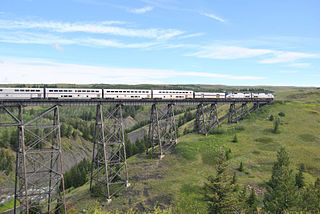Happening Now
Roads less travelled become railroads more travelled
October 17, 2013
Written By Colin Leach

Amtrak's Empire Builder near East Glacier, MT. Credit to Steve Wilson via Wikimedia Foundation.
How should we pay to maintain highways? This question no longer has a straightforward answer. As a recent article in theEconomist suggests, state and federal governments are finding it increasingly difficult to raise the needed revenues to maintain roads.
For most of our history, highways have been paid for through straightforward gas taxes: Under these, a portion of each gallon of gas sold goes to both federal (current rate: 18.4 cents) and state governments to maintain highways. While increasing automobile use over the past few decades drove gas tax revenues progressively higher, this trend has fallen off in recent years. Gas tax revenues now stand at all time lows, as witnessed by the Treasury’s $41 billion bailout of the Highway Trust Fund.
But why are gas tax revenues so low? Many factors play a role. First, the federal gas tax has not kept pace with rising gas prices. The gas tax was last raised in 1990; then, the 18.4 cent tax represented slightly more than 15% of the price of a gallon of regular gas. Now, with the same gallon averaging at $3.65, the same figure represents slightly more than 5%. This discrepancy means that in an era of record highway congestion, the federal government lacks sufficient funds to ensure that bridges are maintained to minimum standards; a reality that has become all too clear since the June collapse of the Skagit River bridge in Washington State.
However, even if the gas tax were increased, there’s no guarantee that it would result in increased revenues. Most cars are becoming more fuel efficient, as required by federal standards, and electric cars (which pay no gas taxes) are more common on American roads than ever before. As a result, nearly half of highway spending comes from general fund transfers and not from dedicated gas revenues.
One state is examining innovative solutions to the problem. Oregon, which was the first state to introduce a gas tax back in 1919, is now considering the adoption of a “Vehicle Miles Travelled” (VMT) assessment. Rather than paying a tax on gas, drivers would be charged based on the number of vehicle miles travelled on roads in a given state. But assessing VMT would require the installation of GPS devices: a proposal that does not sit well with civil liberties advocates. While the ACLU has endorsed a modified proposal in Oregon, concerns about privacy and data retention remain.
Thus, both states and the federal government are at an impasse. While raising gas taxes would be politically impossible and economically ineffective, VMT is fraught with concerns about data protection and invasion of privacy. Unless a solution is found, highways will continue to suffer from poor repair and overcrowding- and Americans’ aggravation will increase.
But rail advocates know there is another solution. Despite anemic federal funding, Amtrak is carrying a record number of passengers. Whether they’re on the Empire Builder across the Dakotas or Montana, or one of the thousands of passengers between Washington and New York on the dozens of daily Northeast Regionals, Americans know the value of trains in their communities. Trains offer a fast, convenient, and reliable alternative to highway gridlock. Best of all, they’re an economic bargain for policymakers.
Consider the example of the Hoosier State between Indianapolis and Chicago. Amtrak and Indiana’s Department of Transportationrecently concluded an agreement to operate the train for a year at a cost of $2.5 million. By comparison, the state’s most recent transportation bill included more than $210 million in funding for new highway construction. Given that most passenger rail infrastructure is maintained by the private railroad companies, passenger rail presents a unique opportunity for taxpayers to improve transportation capacity without imposing a tremendous burden on the public purse.
This reality is even more apparent when considering national figures. As said earlier, the Treasury has bailed out the Highway Trust Fund to the tune of $41 billion over the past several years. Amtrak’s total grants from the federal government in 2012 totaled $1.42 billion.
Imagine what Amtrak could do if they received $4.1 billion- a paltry 10% of the highway bailout! Americans would have more and better travel choices and could take trains to new destinations, as NARP has proposed in our vision for the future.
The solution to our transportation woes won’t be fixed by massive tax hikes or GPS monitoring devices. Only passenger rail can provide the right combination of value and volume to suit our Nation’s growing transportation needs.
"Thank you to Jim Mathews and the Rail Passengers Association for presenting me with this prestigious award. I am always looking at ways to work with the railroads and rail advocates to improve the passenger experience."
Congressman Dan Lipinski (IL-3)
February 14, 2020, on receiving the Association's Golden Spike Award
Comments